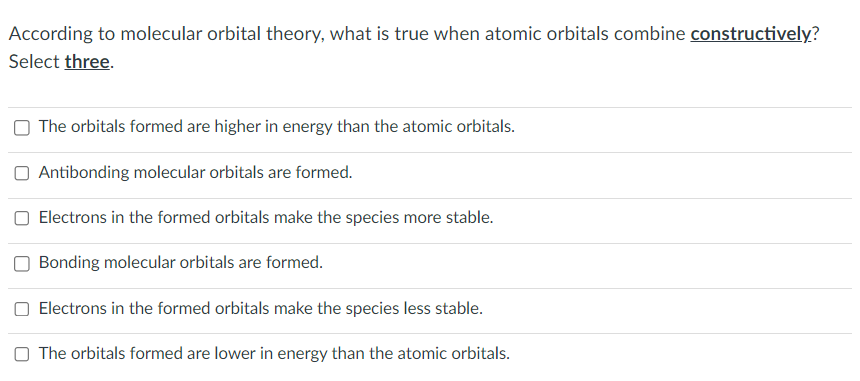Below is an incomplete molecular orbital diagram. Fill in the diagram for the diatomic molecule X2, where each atom of X has 6 valence electrons in s and p orbitals. El la р S B Based on your diagram, [Select] р S substance would be expected to be [Select] bond(s) would be expected to form and the ?
Below is an incomplete molecular orbital diagram. Fill in the diagram for the diatomic molecule X2, where each atom of X has 6 valence electrons in s and p orbitals. El la р S B Based on your diagram, [Select] р S substance would be expected to be [Select] bond(s) would be expected to form and the ?
Chemistry: Principles and Practice
3rd Edition
ISBN:9780534420123
Author:Daniel L. Reger, Scott R. Goode, David W. Ball, Edward Mercer
Publisher:Daniel L. Reger, Scott R. Goode, David W. Ball, Edward Mercer
Chapter10: Molecular Structure And Bonding Theories
Section: Chapter Questions
Problem 10.85QE
Related questions
Question
![Below is an incomplete molecular orbital diagram. Fill in the diagram for the diatomic molecule X2,
where each atom of X has 6 valence electrons in s and p orbitals.
w
р
S
π
р
S
Based on your diagram, [Select]
substance would be expected to be [Select]
bond(s) would be expected to form and the
?](/v2/_next/image?url=https%3A%2F%2Fcontent.bartleby.com%2Fqna-images%2Fquestion%2F41935391-9541-47c4-a0ab-7fda83386b99%2F5c270a29-4286-4485-b4d6-4490ba8a3459%2F6l5832l_processed.png&w=3840&q=75)
Transcribed Image Text:Below is an incomplete molecular orbital diagram. Fill in the diagram for the diatomic molecule X2,
where each atom of X has 6 valence electrons in s and p orbitals.
w
р
S
π
р
S
Based on your diagram, [Select]
substance would be expected to be [Select]
bond(s) would be expected to form and the
?

Transcribed Image Text:According to molecular orbital theory, what is true when atomic orbitals combine constructively?
Select three.
The orbitals formed are higher in energy than the atomic orbitals.
Antibonding molecular orbitals are formed.
Electrons in the formed orbitals make the species more stable.
Bonding molecular orbitals are formed.
Electrons in the formed orbitals make the species less stable.
The orbitals formed are lower in energy than the atomic orbitals.
Expert Solution
This question has been solved!
Explore an expertly crafted, step-by-step solution for a thorough understanding of key concepts.
This is a popular solution!
Trending now
This is a popular solution!
Step by step
Solved in 2 steps with 1 images

Knowledge Booster
Learn more about
Need a deep-dive on the concept behind this application? Look no further. Learn more about this topic, chemistry and related others by exploring similar questions and additional content below.Recommended textbooks for you

Chemistry: Principles and Practice
Chemistry
ISBN:
9780534420123
Author:
Daniel L. Reger, Scott R. Goode, David W. Ball, Edward Mercer
Publisher:
Cengage Learning

Chemistry: An Atoms First Approach
Chemistry
ISBN:
9781305079243
Author:
Steven S. Zumdahl, Susan A. Zumdahl
Publisher:
Cengage Learning

Chemistry
Chemistry
ISBN:
9781305957404
Author:
Steven S. Zumdahl, Susan A. Zumdahl, Donald J. DeCoste
Publisher:
Cengage Learning

Chemistry: Principles and Practice
Chemistry
ISBN:
9780534420123
Author:
Daniel L. Reger, Scott R. Goode, David W. Ball, Edward Mercer
Publisher:
Cengage Learning

Chemistry: An Atoms First Approach
Chemistry
ISBN:
9781305079243
Author:
Steven S. Zumdahl, Susan A. Zumdahl
Publisher:
Cengage Learning

Chemistry
Chemistry
ISBN:
9781305957404
Author:
Steven S. Zumdahl, Susan A. Zumdahl, Donald J. DeCoste
Publisher:
Cengage Learning


Chemistry: The Molecular Science
Chemistry
ISBN:
9781285199047
Author:
John W. Moore, Conrad L. Stanitski
Publisher:
Cengage Learning

Chemistry for Engineering Students
Chemistry
ISBN:
9781337398909
Author:
Lawrence S. Brown, Tom Holme
Publisher:
Cengage Learning